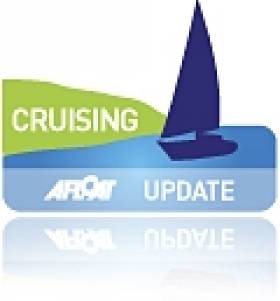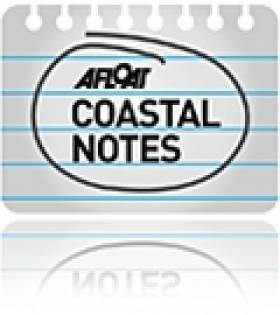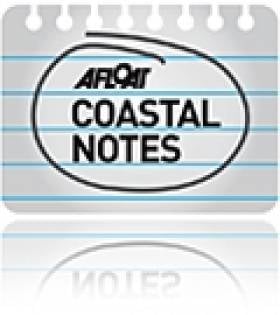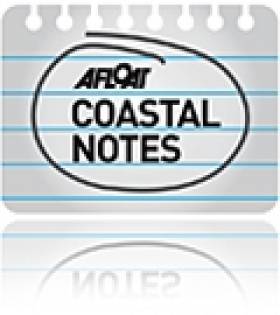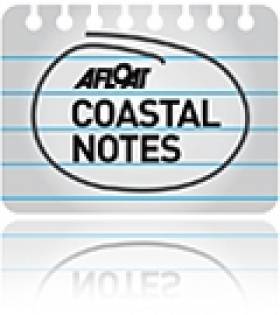Displaying items by tag: Coastal Notes
Sligo Coastal Town's A Sweet Spot On The Wild Atlantic Way
#CoastalNotes - The Irish Independent's Kim Bielenberg recently enjoyed the hospitality of the welcoming coastal community of Strandhill in Co Sligo, where seaweed, surfing and sleeping under the stars are some of the key attractions.
Strandhill is just one of the many seaside hamlets dotted along the Wild Atlantic Way, an initiative local businesses have been swift to latch on to.
But the town's entrepreneurs have long been at one with the ocean and the rugged beauty of the coastline, from the local seaweed bath – a Sligo coast tradition – to the Kiwi-run surfing school and the beach campsite that welcomes hundreds of campers every summer.
Meanwhile, that same coastline provided the inspiration for artists Tom Phelan's seascape, which featured in a recently closed exhibition in Dublin.
Independent.ie has a sample of one of his striking and evocative surfboard paintings, with straight lines and sweeping curves that care calming and sedate, but a rough surfaces that indicates some tussles with the waves.
More of these works can be found on Tom Phelan's website HERE.
Jellyfish Pose Threat To Irish Beachgoers
#MarineWildlife - As if this week's warnings against swimming at 12 North Co Dublin beaches weren't enough, The Irish Times brings news of sightings of the dreaded Portuguese man o'war among other stinging sea creatures flocking to Ireland's warmer waters.
As reported earlier this week on Afloat.ie, Irish Water Safety chief John Leech gave warning of sightings at Bunmahon and Clonea strand in Waterford of the dangerous jellyfish-like species, last seen here in big numbers in September 2012.
But the warm currents flowing towards Irish shores are also likely to bring the lion's mane jellyfish, which packs a sting to match its large size - often 2 metres in diameter.
The Irish Times has more on the story HERE.
North Dublin Beaches Nix Bathing After Pump Station Overflow
#CoastalNotes - After last month's temporary bathing bans for a number of Dublin Bay beaches and swimming spots comes news that 12 beaches in North Co Dublin - a number of which were awarded Blue Flags earlier this summer – are at present not safe for swimming.
As TheJournal.ie reports, the advisory from Fingal County Council relates to pump station overflow caused by the weekend's heavy rains, which has affected the water quality off Balbriggan and Hampton Cove, Loughshinny, Skerries north and south, Balcarrick, The Brook and Tower Bay at Portrane, Velvet Strand at Portmarnock, the Burrow at Sutton and Claremont near Howth.
The advisory will remain in place till the end of this week as council officials collect fresh samples of the coastal waters.
#RadioCaroline- Fifty years ago today, a revolution in radio broadcasting boomed from a ship that dropped anchor off the Isle of Man as the airwaves of Radio Caroline North became the epicentre of 60's pop culture, writes Jehan Ashmore.
The famous pirate radio station of Radio Caroline North, was the brainchild of enigmatic Irishman Ronan O'Rahilly, who based his defiant operation on board M.V. Caroline which anchored three miles offshore of Ramsey on the north-east of the island.
Radio Caroline's southern counterpart anchored in the English Channel, together they where a reaction to the BBC's staid monopoly of the airwaves and avoided UK government control by anchoring outside territorial waters.
A musical kaleidoscope transitted The Beatles, Bob Dylan, The Beach Boys and countless more hits. Not only were thousands of Manx teenagers enjoying the sounds that epitomised the music youth of that era but to the millions of young people in the UK and Ireland.
Of the two stations, Radio Caroline North was the more successful. Employing professional DJ's from the UK but also from the USA, Canada and Australia who released the lastest pop-releases and chart-hit successes. Added to this heady mix of music were very popular DJ's whose exuberant attitude defied the powers of the establishment.
The arrival of such an enterprise led to the Ramsey Steamship Company acting as the ships's agents, which involved tenders supplying provisions and ferrying personnel back and forth to the small port. Afloat.ie profiled Ramsey in a report during May.
A fine model of one of their former general cargo-ships, Ben Varrey is on display in the Ramsey Heritage Centre and is where a wealth of history is to be found including this nautical nugget of information.
Only last year the Ramsey Steamship Co. ceased trading, having begun operations 101 years ago.
The company's second general-cargo, Ben Maye was chartered for a Lockout 1913 centenary event by re-enacting a voyage as the S.S. Hare which brought vital food-supplies to Dublin from Liverpool.
#Superboats – Having spent a week visiting Dun Laoghaire Harbour, the 46m superyacht Christopher that dwarfed the local 500 plus craft and several larger craft currently taking part in the Round Ireland race departed today and follows the anchorage of 37m motoryacht Katrion to the secluded waters off Glengariff, writes Jehan Ashmore.
Such large-sized and luxuriously appointed leisure-vessels visiting Irish waters, reflects not only the high-season, but also demonstrates the appeal of our wonderful scenic cruising grounds where the role of marina's and suitable sheltered seas benefit visitor alike and the local economy.
Christopher, a dark-bull hulled ketch from the design of Ron Holland cannot be easily forgotten even when witnessed in static mode moored alongside an outer-lying berth within Dun Laoghaire Marina.
The Cayman Islands flagged vessel was berthed close to the customs cutter, RCC Suirbheir, where she and her sister, RCC Faire are relatively frequent callers to the marina.
As for the motoryacht, Katrion, the white hulled 400 tonnes vessel launched from Feadship, a leading Dutch specialist of such luxurious leisure boats yesterday anchored off Glengariff having called as reported to Cork City Marina. Likewise her sheer size made an impact along local Leeside craft.
As previously alluded the 10-guest capacity visitor also flying the flag of the these Caribbean islands was due to discover the delights of Dingle, from where Katrion departed for Glengariff.
This she did as the vessel departed Dingle yesterday and took the passage to Glengariff along the spectacular rugged Kerry and Cork coastlines. This included a call to Knightstown, Valentia Island only accessible from the northern approaches due to the low-lying bridge linking the mainland at Portmagee.
Later the motoryacht made a transit through Dursey Sound before heading for her current attractive anchorage in Bantry Bay.
Glengariff is to welcome a considerably larger leisure seeker in the form of the 190m cruiseship Amadea due next month. As previously reported, there are seven callers scheduled this season, with the Phoenix Reisen operated ship to make a repeat call.
Beforehand another caller is expected the eye-catching cruise tall-ship, Club Med 2 due in September.
Kilkee In Limbo Over Finding For Storm Repairs
#CoastalNotes - The Irish Times reports on uncertainly over State funding for repair works to Kilkee's promenade.
Four months after the seaside town – promoted as part of the Wild Atlantic Way initiative - was devastated in the last of the winter's extreme storm period, the roadway and a section of beach below the Strand Line are still fenced off, though repairs have been made to sea walls and pavements.
However, Clare County Council says it is unclear whether Government funding will be forthcoming for the remaining works.
As previously reported on Afloat.ie, €16.8 million was allocated in February to the council for storm-related repairs after January's extreme weather - but the damage to Kilkee, which occurred later, is not covered by this funding.
The Irish Times has more on the story HERE.
80 Blue Flags For Ireland's Beaches & Marinas In 2014
#BlueFlag - 80 swimming spots around Ireland's coast - comprising 76 beaches and four marinas - have been awarded the prestigious Blue Flag for 2014, an increase of six on last year.
And a further 54 beaches were recognised in the National Green Coast Awards, nine more than in 2013.
Blue Flag applications were received for 81 beaches in total, though five beaches - Bertra and Mulranny in Mayo, Rossbeigh in Kerry and Miltown Malbay and Spanish Point in Clare - were not awarded the clean water accolade due to ongoing works to repair extensive damage caused by the winter storms.
However, eight Blue Flags were regained across four local authority areas.
Four were regained in Portmarnock, Portrane, Donabate and Skerries South Beach in Fingal, while Morriscastle in Wexford and Ballybunion North in Kerry regained their Blue Flags after failing to comply with water quality criteria in 2013.
In Waterford, two Blue Flags were regained in Councellors Strand and Dunmore Strand.
Speaking at the awards ceremony at Skerries South Beach today (Wednesday 4 June), Environment Minister Phil Hogan said Ireland's performance in this year's Blue Flag awards is a "testament to efforts of communities, local authorities and An Taisce and the sterling work they do.
"Results might even have been better except for the devastation of the storms last winter which caused significant damage in some areas.”
An Taisce's Patricia Oliver said that “In order to be eligible for the Blue Flag, a beach or marina must comply with strict criteria relating to water quality, safety, facilities for visitors, beach management including litter control, environmental education and the provision of information.”
Meanwhile, Trá gCaorach Inis Oirr in Galway and Kilfrassey in Waterford were first time winners in the National Green Coast Awards, which recognise beaches that may lack the necessary infrastructure for Blue Flag consideration but are judged on "clean environment, excellent water quality and natural beauty".
Some 54 beaches in Ireland were awarded the Green Coast Award, representing an increase of nine awards.
Only Dog’s Bay in Galway lost its Green Coast Award due to considerable infrastructural damage at the beach as a result of the storms.
Oliver added that an important aspect of the Green Coast Awards is the involvement of Clean Coasts groups, of which there are now over 400 comprising thousands of volunteers throughout the island.
“Clean Coasts groups contribute significantly to the protection of Irelands coast," she said. "In 2013 over 700 beach cleans took place and these groups removed over 500,000 items of marine litter from the marine environment.”
“Local authorities, marina operators and local communities should be commended for their efforts in achieving Blue Flag and Green Coast award status today."
The full list of Blue Flag and National Green Coast Awards recipients can be downloaded below.
'The Blueway' – the New Way to Discover Our Coastline
#NewBlueWaySites -The Blueway, a new national initiative to complement the Wild Atlantic Way and to encourage visitors to discover our coastline, was launched by Minister of State for Tourism & Sport, Michael Ring.
The Blueway is a pilot programme to encourage visitors to engage with the sea by developing trails for water activities such as snorkeling and kayaking and highlighting local activity providers and events at the five Blueway locations in counties Mayo and Galway.
Speaking at the launch, Minister Michael Ring said –"Blueways offer an entirely new perspective on Ireland's magnificent wild Atlantic coastline. The Blueway initiative provides visitors with a safe haven to immerse themselves in some of the most glorious coastal waters anywhere in the world."
The five coastal Blueway sites are in Counties Galway and Mayo - Boffin Harbour on Inishbofin, Killary Fjord in Leenane, Keem on Achill Island, and Mannin Bay and Old Head (Louisburgh) in Mayo.
Recent research indicated that over 84,000 overseas visitors engage in water-sports every year when on holiday in Ireland with the vast majority of those taking part in kayaking and snorkeling.
The Blueway project supports the development of kayaking and snorkeling water trails in the pilot locations to support communities to develop new experiences for visitors along the Wild Atlantic Way.
Fiona Monaghan, Head of the Wild Atlantic Way Programme with Failte Ireland, said –"We are delighted to support this initiative, which sees the timely development of an excellent Wild Atlantic Way water sports experience, and provides the visitor the opportunity to engage with the sea. We have seen first-hand the success of the Greenway in Mayo which boosted local tourism with over 200,000 visitors last year. As a maritime variant of that initiative, we hope the Blueway can enjoy the same level of interest from visitors both at home and abroad."
Fáilte Ireland established a group, chaired by Dr Richard Thorn Chairman of the Irish Underwater Council, to progress the pilot programme which included representatives from Canoeing Ireland, the Rural Development Programmes of South Mayo, the Leader companies, Comhdhail na Oilean, Forum Connemara as well as Galway and Mayo County Councils and representation from the Leave no Trace initiative.
Over the summer months a series of "Blueway Days" will take place at the pilot locations to encourage visitors to engage with the sea.
These 'Blueway Taster days' have been devised to create awareness of the Blueway locations and the activities that are on offer.
Local activity operators will be available on the day to provide tuition and equipment together with safety advice to anyone that is interested in snorkelling /kayaking at these locations.
So whether you're a land lubber or a salty sea dog, local instruction and support will be there to suit every ability.
In addition to support from Failte Ireland, the project is supported by the Leader programme.
#CoastalNotes - The Environmental Protection Agency (EPA) insists there was "nothing underhand" about its amendments to a 2007 licence for Shell's gas terminal at Bellanaboy in Co Mayo.
The Irish Times has a report on Tuesday's opening remarks of a three-day action at the Commercial Court, where it was alleged that the EPA intended to amend an earlier licence for the facility despite a more recent one being quashed by the High Court over environmental concerns.
As previously reported on Afloat.ie, local man Martin Harrington had claimed the EPA failed to carry out a proper Environmental Impact Assessment of the north-west Mayo region to meet EU requirements.
The outcome of that case last October was hailed as a victory for the long-time campaign against the controversial Corrib Gas Project.
Harrington's latest action is a judicial review challenge aimed at quashing the amendments to the 2007 licence. The Irish Times has more on the story HERE.
Trump Trumpets Jobs On Visit To Clare Golf Links
#CoastalNotes - Billionaire businessman Donald Trump has arrived in Ireland amid much pomp and circumstance, promising "hundreds" of jobs in Co Clare, according to TheJournal.ie.
As previously reported on Afloat.ie, Trump purchased the former Doonbeg Lodge and Golf Club on the Clare coast for a bargain €15 million after it went into receivership in January during the extraordinary stormy winter.
Subsequently the US Apprentice host became embroiled in a brouhaha over the fate of an endangered snail species that lives on the property, after he sent in lorry-loads of rock armour to shore up coastal defences without the requisite planning permission.
This morning (Monday 12 May) Trump arrived at Shannon Airport to a red carpet welcome, complete with a harpist, fiddle player and singer to play his alighting from his personal branded aircraft, before meeting Finance Minister Michael Noonan and local dignitaries.
On the agenda for the next three days will be Trump's ambitious plans for the golf resort, including the addition of a "truly great ballroom" that would "generate a lot of jobs".
He also pledged to work with environmentalists over the habitat of the narrow-mouth whorl snail - though dismissed claims that the tiny mollusc was unique to Doonbeg.
TheJournal.ie has much more on the story HERE.
































